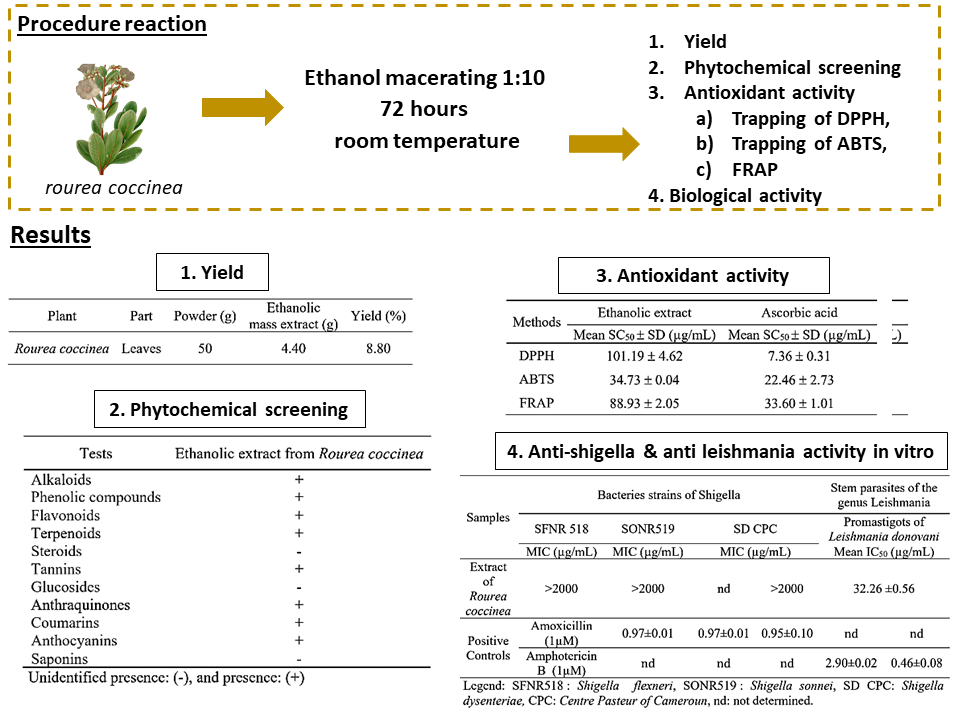Phytochemical screening, antioxidant, antishigella and antileishmanial activities of ethanolic extract of Rourea coccinea (Schumach & Thonn.) Benth leaves
Abstract

Rourea coccinea is a widely used medicinal plant worldwide, especially in West Africa. The phytochemical screening of the ethylanolic extract of leaves carried out according to the method of Houghton and Raman with some modifications, revealed the presence of alkaloids, phenolic compounds, terpenenoids, tannins, coumarines, anthocyanins and anthraquinones. The antiradicalar tests were performed using DPPH (2,2-diphenyl-1-picryhydrazyl), ABTS (2,2-azino-bis (3-ethylbenzo-thiazoline-6-sulfonic acid) diamum salt) and FRAP (Ferric Reducing Antioxidant Power) with a Scavenging concentration 50 (SC50) of 101,19 µg/mL, 34.73 µg/mL and 88.93 µg/mL respectively. The antishigella activity of the extract determined by the microdilution method was low. According to Jair Siquera-Neto et al., the antileishmanial assay using the colorimetric resealing method showed activity against promastigous strains of Leishmania donovani with an inhibitory concentration of IC50=32.26 µg/mL. The traditional use of Rourea coccinea, in the treatment of several diseases, would be justified by these pharmacological properties tested.
References
[1] Zhao, J., Yuan, Q., Wang, H., Liu, W., Liao, X., Su, Y., Wang, X., Yuan, J., Li, T., Li, J. Clin. Infect. Dis. 2020, 71, 2027–2034.
[2] Tabish, S.A., Nabil, S. Int. J. Sci. Res. 2015, 4, 2427–42
[3] Huigang, L., Xiaowei, X., Cui, H., Haixia, M., Zhiming, Y. J. Biosaf. Biosecurity. 2020, 2, 23–26.
[4] Snacel, S. et Hadjaz, K. PhD Thesis, Université Mouloud Mammeri, 2022.
[5] El Rhaffari, L., Hammani, K., Benlyas, M. et Zaid, A. Biologie & Santé. 2002, 1(1), 45-54.
[6] Fournet, A., Hocquemiller, R., et Gantier, J. C. Recherche.1995, 26(451), 424-429.
[7] Vaissaire J., Laugier C., Baroux D., Plateau E., Laroche M., Mirial G., Coconnier M.H., Hardy J., Bull. Acad. Vét. Fr. 1987, 140(3), 385-391.
[8] Andryukov, B., Mikhailov, V., Besednova, N. J. Mar. Sci. Eng. 2019, 7, 176.
[9] Gori, A. PhD Thesis, Université Grenoble Alpes, 2020.
[10] Grigoraş, C.-G. PhD Thesis, Université d’Orléans; Universitatea Vasile Alecsandri din Bacău (România), 2012.
[11] Fowler D.G. Kirkia 2006, 18, 35–48.
[12] Bello, A., Jamaladdeen, S., Elder, M.T., Yaradua, S.S., Kankara, S.S., Wagini, N.H., Stirton, C.H. and Muasya, M. Bothalia-African Biodiversity & Conservation. 2019, 49(1), pp.1-17.
[13] Ahmadu, A. A., Haruna, A. K., Sule, M. I., Pateh, U. U. et Akpulu, I. N. Planta Med., 2006, 72(11), 203.
[14] Bero, J., Ganfona, H., Jonville, M-C., Frédérich, M., Gbaguidi, F., DeMol, P., Moudachirou, M., Quetin-Leclercq, J. J. Ethnopharmacol. 2009, 122(3), 439-444. doi: 10.1016/j.jep.2009.02.004.
[15] Dosseh, K., Kokou, I., Agbodjogbe, W. K. D., Et Agbonon, A. W. J. Adv. Res. Rev. 2022, 15(3), 269-277.
[16] Dougnon, V., Legba, B. B., Gbaguidi, B., Agbodjento, E., Agbankpe, A. J., Rocha, D., Ayi, I., Azonbakin, S., Diallo, A., Bonkoungou, I.J., Klotoe, J.R., Agbangla, C. and Alitonou G.A. Int. J. One Health. 2022, 8(2), 124–160
[17] Ibrahim, M. A., Mohammed, A., Isah, M. B. et Aliyu, A. B. J. ethnopharmacol. 2014, 154(1), 26-54.
[18] Goueti, B., Kpadonou-Kpoviessi, B., Ahoussi, L., Glinma, B., Tchinda A., Tchokouaha L., Gbenou, J, Lenta, B. and Kpoviessi, S. J. Pharmacogn. Phytochem. 2023, 12(3): 150-155.
[19] Bassène, E. Presse, Universitaire de Dakar : Dakar, 2012, 17,94-96..
[20] Sy, A. N., Fall, A. D., Ndiaye, M., Ndiaye, K., Gueye, R.S., Bassene, E., Amadou, M. Dieye, A.M. et Sy, G.Y. Int. J. Biol. Chem. Sci.. 2018, 12(4), 1816-1823.
[21] Dieng, S.I.M., Fall, A.D., Diatta-Badji, K., Sarr, A., Sene, M., Mbaye, A., William Diatta, W. et Bassene, E. Int. J. Biol. Chem. Sci. 2017, 11(2), 768-776.
[22] CLSI., « Methods for Dilution Antimicrobial Susceptibility Tests for Bacteria That Grow Aerobically; Approved Standard — Ninth Edition, 2012, 32(2).
[23] Siqueira-Neto, J.L., Song, O-R., Oh, H., Sohn, J-H, ,Yang, G., Nam, J., Jang, J., Cechetto, J., Lee, C.B., Moon, S., Genovesio, A., Chatelain, E., Christophe, T., Freitas-Junior, L.H. PLoS neglected tropical diseases. 2010, 4(5), e675.
[24] Agbodjento, E. Klotoé, J., Sacramento, I., Dougnon, V., Hounkpatin, M., Dougnon, J., Atègbo, J. Int.l J. Biosci. 2020, 16(4), 230-240.
[25] Jutras, S.et Plamondon, A. P. Écoscience. 2021, 28(1), 1-31.
[26] Joel, A. D., Hospice, D. G., Cossi, A. A., Aristide, H. G. H., Brice, T.et Brice, S. A. Eur. Sci. J.. 2017, 13(30), 1857-7881.
[27] Dosseh, H. K., Ahozonlin, M. C. et Dossa, L. H. Vet; Anim. Sci.. 2021, 14, 100-210.
[28] Said, A. A. H., El Otmani, I. S., Derfoufi, S. et Benmoussa, A. Hegel, 2016, 3(3), 280-292.
[29] Emmanuela, I. N., Anthony, C. M., Ejike, E. U. et Onwumere, S. I. Afri. J. Microbiol. Res. 2019,13(20), 332-340.
[30] Bero, J., Hannaert, V., Chataigné, G., Hérent, M.-F. et Quetin-Leclercq, J. J. Ethnopharmacol. 2011, 137(2), 998-1002.
[31] Tasdemir, D., Kaiser, M., Brun, R., Yardley V., Thomas, J.S., Tosun, F., Rüedi, P Antimicrob. Agents Chemother. 2006, 50(4), 1352-1364.
[32] Cheikh-Ali, Z., Caron, J., Cojean, S., Bories, C., Couvreur, P., Loiseau, P.M., Desmaële, D., Poupon, E., Champy, P., Chem. Med. Chem. 2015, 10(2). 411-418.
Refbacks
- There are currently no refbacks.

This work is licensed under a Creative Commons Attribution-NonCommercial 4.0 International License.








